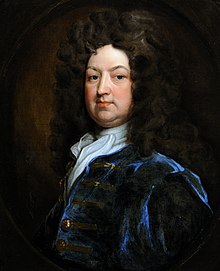Charles Churchill (British Army officer, born 1656)
Charles Churchill | |
|---|---|
 A painting of Charles Churchill by the circle of Godfrey Kneller | |
| Born | 2 February 1656 |
| Died | 29 December 1714 (aged 58) |
| Allegiance | |
| Service | English Army |
| Rank | General |
| Commands | 3rd Regiment of Foot Coldstream Guards Centre / Allied Army |
| Battles / wars | Monmouth Rebellion |
| Relations | Winston Churchill (Father) Elizabeth Drake (Mother) |
| Other work | Lieutenant of the Tower of London Governor of Guernsey Member of Parliament |
General Charles Churchill (2 February 1656 – 29 December 1714) was an English politician and army officer who served during the War of the Spanish Succession. He was a younger brother of John Churchill, 1st Duke of Marlborough. His career was closely connected with his brother's and along with Marlborough's Irish Chief of Staff William Cadogan was one of his closest advisors.
Life
Churchill was the son of Winston Churchill (1620-1688) and Elizabeth Drake. Charles was a page and later a gentlemen in the household of Prince George of Denmark and became Lieutenant of the Tower of London in 1702.[1]
Charles Churchill joined the English Army as an ensign in the 3rd Regiment of Foot in 1674 and later received the colonelcy of that unit. He fought in numerous wars and battles, including Sedgemoor during Monmouth's Rebellion. He served under his brother when he captured Cork from its Jacobite Irish Army garrison in 1690. He then served on the continent at the Steenkerque and Landen. Churchill was promoted to brigadier-general in 1690 and to major-general in 1694.
He became a lieutenant-general in 1702, at the same time receiving the colonelcy of the Coldstream Regiment of Foot Guards, and finally was made a full general in 1707.[1] During the March to the Danube he oversaw the artillery and infantry contingents. At Blenheim, serving under his elder brother John Churchill, 1st Duke of Marlborough, he commanded the center of the allied line. At the battle of Ramillies, again serving under his brother, he ordered four brigades of foot to attack the village.
He resigned his Lieutenancy of the Tower in 1706, and he served as Governor of Guernsey from 1706 to 1711.[1]
Family
Churchill married Mary Gould, daughter of James Gould (later married to Montagu Venables-Bertie, 2nd Earl of Abingdon). [1]
He was the father of Lieutenant-General Charles Churchill, by his mistress Elizabeth Odd, and the grandfather of Charles Churchill (of Chalfont) by his son's mistress, the actress Anne Oldfield. His grandson married Lady Maria Walpole, illegitimate daughter of Robert Walpole, and had issue including Mary Churchill (2nd wife of the Earl Cadogan and ancestor of later earls). [1]
His sister was Arabella, a royal mistress of King James II of Great Britain, and his brother George became an admiral.[2]
Notes
- ^ a b c d e Courtney 1887.
- ^ Holmes: Marlborough: England's Fragile Genius, ISBN 9780007225712 p. 42. Winston, Henry, Jasper, and Mountjoy all died in infancy. Theobald died in 1685.
References
- Courtney, William Prideaux (1887). . In Stephen, Leslie (ed.). Dictionary of National Biography. Vol. 10. London: Smith, Elder & Co.
- Snell, Elizabeth Churchill. "Churchill, Charles (1656–1714)". Oxford Dictionary of National Biography (online ed.). Oxford University Press. doi:10.1093/ref:odnb/5396. (Subscription or UK public library membership required.)
- Use dmy dates from April 2012
- 1656 births
- 1714 deaths
- British Army generals
- Buffs (Royal East Kent Regiment) officers
- British military personnel of the War of the Spanish Succession
- Coldstream Guards officers
- Lieutenants of the Tower of London
- English MPs 1701–1702
- English MPs 1702–1705
- English MPs 1705–1707
- British MPs 1707–08
- British MPs 1708–10
- Members of the Parliament of Great Britain for English constituencies
- Spencer-Churchill family
- 17th-century soldiers
